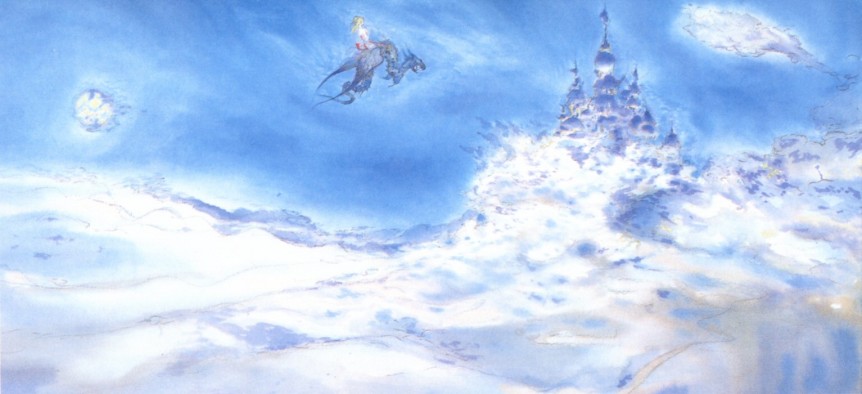Let’s start part 3 with a quick explanatory note that probably should have been in part 1. Those unfamiliar with the Final Fantasy franchise may not realize that successive Final Fantasy games are not sequels in the usual sense, and indeed the whole thing is not really one franchise, but several. Each main “numbered” Final Fantasy game takes place in a different world, with different characters, and often enough significant changes to the basic gameplay from its immediate predecessor. No Final Fantasy games had sequels in the usual Western sense (continuations of the same story, with characters and/or a setting in common with earlier instalments) until after the merger that created Square-Enix, and those that exist have names like Final Fantasy X-2, i.e. the second game in the Final Fantasy X series.
tl;dr: Final Fantasy V (for example) is not a sequel to Final Fantasy IV in the way we normally use the word, but Final Fantasy IV: The After Years is (albeit a terrible one that is a total insult to FFIV and you should avoid at all costs). And similar comments apply to other entries in the series.
This may explain a few things people new to the series might have found confusing so far, and it will get important in this entry when, despite taking place mostly in the mid-90s, I briefly discuss the Final Fantasy XIII games.
If you’ve read the previous entries in this series at all carefully, you’ll realize that the Internet didn’t play much of a role in my early experience of the Final Fantasy games.
Technically, the Internet has existed since before I was born, but basically no-one had heard of it until the early 90s. Personally, I had no use for the Internet – or rather, mistakenly believed I didn’t – until well into university.
Though I was, at the time, flirting with being a compsci major, the actual triggering event was a particularly prescient philosophy prof insisting that a class I was in submit papers by e-mail. In effect this forced everyone to get computer accounts. No-one in the compsci department did anything like this while I was there, apparently content to receive poor-quality printouts of our code and grade them by hand. This seems hilarious in hindsight (though what programmers will find even funnier is that we were mostly writing in Pascal). I recall even at the time vaguely feeling like the methodology was inappropriate for the subject matter, but no-one I knew of had really articulated an alternative.
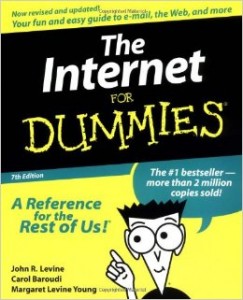
The first edition (from 1993) was almost more hindrance than help by 1995, so rapidly were things changing.
The media was talking about this “new” Internet thing enough that I was independently interested in it. I hadn’t done anything about it up until now, but since I was being forced to connect to it anyway, I started poking around it in my spare time. Aided by what I soon realized was an already-badly out-of-date edition of The Internet for Dummies, I started checking out things like Gopher and WAIS. That was the first edition ever, some quick Internet research suggests (the book is now on its 14th edition, which I doubt has a single sentence in common with the one I read). An almost vestigial chapter covered a new-fangled thing called the World Wide Web, with little discussion of a graphical browser – those didn’t exist yet when the first edition was written, but did by the time I read it, which was aggravating. Nowadays, of course, the Web is so often conflated with the Internet that I probably just blew someone’s mind merely by implying that they’re not the same thing. In any case many of the available machines were text-only UNIX terminals that couldn’t have rendered the Web in any way we’d recognize today.
So if my earlier mentions of, say, not knowing the original Japanese numbering of the Final Fantasy games made you wonder “why didn’t he just Google it?”, now you have a pretty good idea of the answer.

Gopher in all its glory. In 1995 it didn’t need to spell out the “predates the Web” part. People like me would have been like “what Web?”.
It might not have occurred to me anyway. (And not just because there wasn’t Google for another two years; my early search engines of choice were Yahoo and Altavista.) My main obsession at the time – you may have caught a hint of this in the previous instalment of Crystal Memories – was Pink Floyd, followed closely by tabletop RPGs like Dungeons & Dragons. I recall spending an afternoon downloading everything Gopher could give me about the former band. A lot has changed since then – I wonder how many people reading this will even know what Gopher was? – but one crucial thing has remained the same: a clear majority of it was crap. Most of it was transcriptions of lyrics (what was the point? most of the albums had lyric sheets) or heartfelt but painfully badly-written gushes about this album or that concert. There was one really good article by the late Nicholas Schaffner (also used as the epilogue to his book A Saucerful of Secrets, as I would soon learn), and some other sort of interesting stuff like a pretty good list of who sung on what tracks.
This latter document indirectly led me to Usenet, where I was to be a semi-regular presence for almost a decade, at first almost exclusively in the Pink Floyd newsgroup, but in the long run mostly in tabletop RPG groups. (Of which I’ll almost certainly discuss rec.games.frp.advocacy here at some point, but this isn’t the right context.) As would prove to be the case for many other corners of the Internet over the ensuing years, Usenet had an oddly addictive quality even when in practise my time there was largely spent getting into pointless arguments with strangers. That’s not to say nothing educational or constructive ever came of it. There are other and better examples, but one that’s particularly salient here is that it was the way people on Usenet talked about the Web that made it clear to me that the latter was where the action was going to be for the foreseeable future. But I’d have figured that out pretty quickly no matter what.
At some point probably in the fall of 1995, it occurred to me that there might be more to be learned about these Final Fantasy games. By this point, I’d have also played Chrono Trigger, and noticed that, while not carrying the Final Fantasy name, it was made by the same company and had many of the same gameplay elements. This made SquareSoft… well, approximately four for five on making games I really enjoyed and that would go on to influence my own designs. They had clear winners with the games I knew as Final Fantasy II, Final Fantasy III, and Chrono Trigger, and at the time I saw the original Final Fantasy as well as Final Fantasy Mystic Quest as having about one excellent game’s worth of positives between them. So these SquareSoft guys seemed worth learning more about.
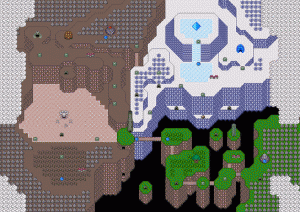
In the center of this map is the Focus Tower, which links together what are effectively four different worlds, being the only feature they all have in common. And now you know everything worth knowing about the only good idea in Mystic Quest.
Oh, yes. Mystic Quest. Let’s pause the narrative to talk about that. Honestly, my current assessment of this game would be pretty savage, though that’s mostly because of hindsight and context I didn’t have then; I enjoyed it reasonably well at the time. But even in 1993 or whenever I would have played it, I don’t see how it could be plausibly claimed that Mystic Quest did anything that wasn’t done substantially better by at least one other, roughly contemporaneous, Square title. Indeed, the most interesting thing there is to say about Mystic Quest is why it went so wrong relative to Square’s other games of its time.
If I found Mystic Quest a little less satisfying than other Final Fantasy titles, at the time I would probably have attributed this to the fact that it was clearly being marketed to a younger audience, and was simplified accordingly. For example, you controlled only two characters at a time, compared to four or five in the other then-extant games of the series, and the storyline has little of the darkness and tragedy – and character development – of IV and VI. But that’s not really the problem. These restrictions perhaps put an upper bound on how good it was possible for the game to be, but it still could have been very good. The problem wasn’t marketing the game to kids, it was marketing the game to American kids. Or rather, to Square’s stereotype of American kids.
Square did (and does) many things very well, but one thing I can’t get behind is their attitude to non-Japanese gamers, who they’ve repeatedly failed to understand, seemingly not for lack of trying, but from trying too hard. As far as I can honestly see, North American gamers, or at least North American gamers who Square has a hope in hell of selling their style of games to, do not differ significantly from Japanese gamers. To try to figure out the ways they’re different and market around them is a waste of time and resources that could be better spent just making the damn games you were going to make anyway. Mystic Quest, we know now, was created because Square thought Final Fantasy V was too complex for the American RPG audience. Quite why they should have this attitude toward the people who had made hits out of the Ultima, Wizardry, and Might and Magic lines, not to mention Square’s own previous titles, has never been explained to my satisfaction. (Yes, those titles are mainly associated with computers rather than consoles, but guess what? At least one game from each of those franchises made it onto the same Nintendo boxes Square was making games for.) But the fact remains that Mystic Quest only exists because some condescending prick of a Square executive though it was what the American (and Canadian) market wanted.
And the problem with that, let’s be clear, is not that they misjudged the market. Or at least that’s not the main problem. At a time when making the games they wanted to make and trusting their audience to keep up had given them hit after hit, suddenly they’d reversed course for no particular reason beyond cultural stereotyping. That is the problem – that suddenly “judging the market” was a factor in the first place, in a way that hadn’t previously been the case. The result, predictably, was a mediocre-at-best game that it was clear no-one’s heart was really in. The previous Final Fantasy games had started as projects someone was passionate about, not as projects someone focus-grouped their way into thinking might sell well. Commercial success, for Square as for so many that try to make a business of creative work, does not seem to be best achieved by directly aiming at it.
This illustrates a cycle that Square has gone through again and again over the years – eventually affecting even Japanese releases in the main Final Fantasy series. A surprising number of the things that went wrong with Final Fantasy XIII, for example, were the same things that went wrong with Mystic Quest like 15 years earlier, and for similar reasons. Misunderstanding non-Japanese markets has been a factor in many of Square’s more ill-advised moves, in this case because Final Fantasy XIII was consciously designed for an international audience due to Square overreacting to a downturn in the Japanese video game market. (Notwithstanding that it contains the single most distinctly Japanese touch in the series, Snow dropping to his hands and knees and bowing his head when he’s begging the forgiveness of Hope’s father.) But as before, that was the less important of two main problems, the larger one being allowing such business considerations to have so much influence on creative decisions in the first place.
The criticisms of the resulting games, too, are remarkably similar. Both are so linear Final Fantasy IV is a sandbox by comparison. Both are overly derivative in some places, different seemingly for the sake of being different in others, with little sign of a coherent unifying vision. Both feel like no-one’s heart was really in it; they’re games you’d expect from a huge team making compromise after compromise, producing something all of them feel kinda-OK about but none were passionate about.
In the case of Mystic Quest and the North American market, Square recognized their error and promptly reversed course. Their next major move in North America was to release Final Fantasy VI renumbered to III, but otherwise in pretty much its original Japanese form. They got a Westerner to do the translation sort-of-right, they let Amano’s weird-ass artwork run wild on this side of the Pacific for the first time, they bowdlerized the game as little as humanly possible given Nintendo’s policies at the time, they trusted us to eat it up, and we did.
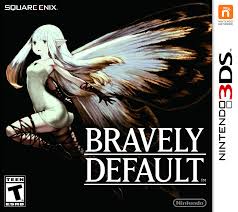
A welcome return to form in a game that could only have come from the makers of the classic Final Fantasy games. Naturally, it got next to no promotion and almost wasn’t even released in North America. And was a hit anyway.
More recently, Bravely Default’s success has Square-Enix executives openly admitting they’ve judged poorly and that Final Fantasy has lost its way. Bravely Default (the first game in a new series, though widely considered a Final Fantasy in all but name) seems to have sold about as well as Final Fantasy XIII: Lightning Returns (the second and final direct sequel to Final Fantasy XIII), despite being released on fewer platforms, getting far less marketing, and not having Final Fantasy’s name recognition. Hopefully the contrite talk is followed by something that pulls Square out of its creative slump. In this case it will be a while before we can really tell given the length of development cycles these days, but the days of Final Fantasy games being labours of love that mostly represent a singular creative vision may not be entirely behind us.
This may all sound very idealistic, but I’ve taken a good hard look at several different creative industries and in every case (except maybe the Hollywood of recent years), the most reliable path to lasting success seems to be getting (or lucking into) the most talented, visionary people available and letting them do more or less whatever the hell they want. It doesn’t guarantee anything, but neither does anything else, least of all trendy corporate focus-grouped compromise.
Okay, that was a bit longer of a digression than planned; certainly it’s more words than Mystic Quest deserves in this context. But the point seemed to want making somewhere in this series and Mystic Quest was as good an excuse as any. But I’ve gotten way ahead of myself. Mystic Quest is only tangentially related to the reason I was talking about the Internet of the mid-90s, which is the flood of information about the Final Fantasy series that it quickly turned into for me as soon as I had eyes to look.
At this time, the best place for Final Fantasy related information in English was then known as the UnOfficial SquareSoft Homepage, so capitalized. You might know the site this eventually turned into – none other than RPGamer. I was delighted to discover, while researching this post, that someone has archived what the site looked like in August 1996 (link no longer works as of August 2019 🙁 ), probably a few months after I first discovered it. That isn’t exactly how I remember it, but it’s close, and as it says right on the page, “These pages are under constant construction and deconstruction. Things are changed and rearranged without warning.”
From this and other sites I can’t remember and that probably no longer exist, I learned that the games I knew as Final Fantasy II and III were really IV and VI respectively, which implied the existence of at least three hitherto unknown games in the series, and of particular interest, one that had been released between the two really impressive ones I was familiar with, which suggested it might be similarly impressive. One of those other sites went into great detail on the job system of Final Fantasy V, which pretty much had me drooling; this level of mechanical customization was one of the few things from other RPGs that I’d missed in the SNES Final Fantasy titles that had been translated.
I’d discuss the reasons these games weren’t initially released here, but I actually already covered it in that long digression on Mystic Quest and FFXIII. At least in the case of Final Fantasy V, it was a case of thinking the gameplay would be too advanced for the North American audience. FFV does indeed have a lot of potential complexity with the job system, but it’s nothing someone who’s been at all successful at playing, say, the Wizardry series can’t handle, and in any case it’s not as though you need to explore this element to the fullest to finish the game. As subsequent rereleases have shown pretty conclusively, there’s no reason FFV couldn’t have done similar business to its immediate predecessor and successor in North America.
(The original Japanese Final Fantasy II and III didn’t initially make it over here for a different reason – bad timing. Both were originally created for the Famicon, known to non-Japanese gamers as the original Nintendo Entertainment System. Square didn’t decide to do an English-language version of the original game for a few years and by the time it was clear that they had a success on their hands here as well as at home, the Super Famicon/SNES was around the corner. There seemed little point in localizing those games for a lame-duck platform when they could localize FFIV for the new platform instead.)
Final Fantasy II, III, and V (original Japanese numbering) were not to be released in English until 2003, 20061, and 1999 respectively, the latest entry of the three reaching these shores first. It was probably the most marketable of the lot, even if it did seem rather strange for games named Final Fantasy V and VIII to be released at practically the same time. Certainly V most interested me out of the early Nintendo-platform titles, and thanks to emulation and the famous fan-made RPGe translation patch, I was playing Final Fantasy V a good year and a half before it could officially be found on these shores. The storyline, it must be said, didn’t hold a candle to those of the games before and after, but for my personal tastes, the deeper gameplay went a long way toward making up for that. Emulators of that time were sometimes buggy, so for example, in the ship’s graveyard, graphical layers were rendered in the wrong order, resulting in not being able to see much besides the surface of the water. A simple change to an emulator setting fixed this, but that required realizing it needed to be fixed; I spent my first play-through thinking this was an intentional choice by the designers, to make this “dungeon” harder.
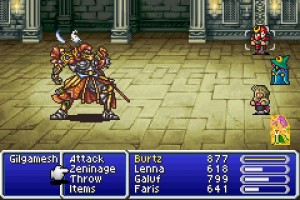 Now we fight like men! And women! And women who dress like men!
Now we fight like men! And women! And women who dress like men!
(I don’t know what version this is – when was the leading man “Burtz” rather than “Butz” or “Bartz”?)
1 And then in a dramatically overhauled form. It’s actually fair to say the original FFIII was never translated, barring fan works similar to the ones that let me play FFV early.
I remember playing all the way through the first world on the fence about whether this deserved to be considered a “real” Final Fantasy or more of another Mystic Quest (for one thing, the fact that the fan translation rendered the main character’s name as “Butz” made it hard to take seriously). I wasn’t convinced that this game was for real until the first battle with Gilgamesh. His wonderfully loopy dialogue notwithstanding, it was ultimately Uematsu who swayed me. There’s something just irresistably fun about “Clash on the Big Bridge”, which has deservedly become one of those compositions heard in multiple Final Fantasy games. It’s not likely to bring a tear to your eye like, say, “Aeris’ Theme” (unless you have traumatic memories of trying to steal a full set of Genji equipment from Final Fantasy XII‘s version of Gilgamesh), but each of these tracks does a great job of evoking the mood of the game in which it originated. Ultimately, Final Fantasy V, though possessing at least one heartbreaking moment of its own, is the fun entry in the series, particularly out of those that originated on the SNES. If you’re playing the series in order, V’s sense of humour and relatively anodyne theme of “family” make it a good chance to catch your breath between the much heavier games surrounding it. If I can’t rate it as highly as IV or VI, neither can I level any really serious criticisms its way. It’s a different thing from IV and VI, but there’s nothing wrong with that thing or how Final Fantasy V goes about being it.
To me, though, the most important document on the UnOfficial SquareSoft Home Page – still available through the archive link above, and at GameFAQs, RPGamer, and many other places – was the Final Fantasy II Handbook by one Ben Siron. This attempted to lay out the internal mechanics of FFIV, mostly pretty accurately. I’m pretty sure Siron was figuring them out from experimentation, not examining the source code or translating a Battle Ultimania like more recent writers of similar documents. (As a much shorter aside than the last one, I can’t be the only North American fan who’d have an orgasm if the Ultimania books came out in English, can I?) Still, there was something oddly inspiring about Siron’s handbook. It was very much like a tabletop RPG manual, for all that the system it described was, by tabletop standards, incomplete, and wouldn’t have worked well without computerized assistance. And while I’ve since lost almost all patience with the way tabletop RPGs are typically written, at the time I could have gobbled those books up all day, and indeed, often did.
Siron didn’t quite spell this out (all he did was say something like “damage from an attack is on average roughly _______” where the blank was an equation that, with the tabletop RPG designer’s eye I had even then, was very obviously the end result of what I’m about to describe), but it was apparent from this document that Final Fantasy IV used a die pool system not dissimilar to White Wolf’s then-popular line of tabletop RPGs whose flagship was Vampire: the Masquerade. It used (electronic) percentage dice rather than d10s, which is much more practical for a computer than a human, but otherwise it was much the same idea. I’ve since seen the algorithm spelled out by people who’ve hacked the source code, and it’s basically the most natural-to-a-computer way you could possibly implement opposed rolls with a dice pool.
It’s not a coincidence that Fantasy Infinity uses opposed rolls with a dice pool. The very simple and fast d6-based die pool system I’m using wasn’t inspired by Vampire or Shadowrun as a tabletop RPG person might assume; it’s the end result of years of trying to simplify down Final Fantasy IV‘s core algorithm to something that works in a tabletop game. It went through many different iterations, including a version I put a lot of effort into that used custom cards rather than dice. (It was a neat idea with some elements I’m still proud of, but in the context of an RPG adventure with a lot of combat it ran into problems. You went through cards very fast, so you needed to shuffle a lot, so the action got interrupted for no in-world reason too often for my tastes. It would still probably have run faster than, say, Pathfinder, but not to the desired degree, and in a way that sometimes felt slower than it actually was because of the interruptions.) In the end I figured out ways to do everything I wanted adequately with only d6s, and a lot of the effort since has gone into making them as streamlined as possible. It still won’t play quite as fast as a video game can, but I think it’s as close to that as you can get at a tabletop without sacrificing the tactical game entirely – close enough that the added flexibility of a human GM more than makes up for the difference.
So, that’s a few snapshots of being a Final Fantasy fan between roughly 1995 and early 1997 (with the long digression on Mystic Quest and Final Fantasy XIII spanning periods both a little earlier and much more recent). Nowadays there’s a Final Fantasy wiki with 18,000 articles and nine million copies of Final Fantasy VII out there and even people who don’t know a D-pad from a stepdad can at least say “Final Fantasy, that’s the one with the guy with the spiky hair and the big-ass meat cleaver sword, right?”. None of that seemed conceivable back then.
Final Fantasy VII wasn’t in North America yet, but everyone who paid attention to videogames knew what it had achieved in Japan and it was pretty much a foregone conclusion that it was going to change everything forever.
And it did.
To be continued…
… but probably not for quite some time, as mentioned in the previous entry. This one ended up the size of a term paper and almost every sentence presented some difficulty; autobiography just doesn’t come naturally to me. I feel like there’s things to say about later Final Fantasy games, especially VII and X, but right now I don’t have specific plans for what those posts would actually be like. I’d rather write good entries when I’m inspired to than mediocre ones now, especially given how much these take out of me.
COMMENTS DISABLED ON THIS POST ONLY, BECAUSE MY MODERATION QUEUE IS GETTING BOMBARDED WITH SPAM AND IT’S ALMOST ALL DIRECTED AT THIS ONE ENTRY. IF YOU HAVE SOMETHING TO SAY I’D LOVE TO HEAR FROM YOU; PUT YOUR COMMENTS ON ONE OF THE OTHER CRYSTAL MEMORIES POSTS, OR THE LATEST POST.
